Cement composites are the most commonly used construction materials worldwide; however, their brittle nature associated with crack propagation limits their application[1]. Natural fibers such as sisal, coir, jute, and hemp have received great attention as reinforcing agents for cement composites, owing to their biodegradability, environmental sustainability, low cost, and good mechanical properties. The incorporation of natural fibers into cement composites can increase the mechanical strength of the composites and mitigate shrinkage cracks[2-3]. However, the degradability of natural fibers in alkaline cement composites limits their reinforcing capacity[4-8].
To mitigate the degradation process of natural fibers in cement composites, the alkalinity of the cement matrix is commonly reduced through the partial replacement of ordinary Portland cement (OPC) with pozzolanic supplementary cementitious materials (SCMs)[8-11]. However, the amount of SCM added is substantially greater than the common range in concrete engineering, which may not only increase cost but also deteriorate the workability of fresh concrete. The degradation behaviors of natural fibers at various pH conditions need to be well understood to ensure the effective regulation of the SCM-OPC cementitious material. Moreover, the alkalinity of the cement pore solution can reach a high level within a short period, even in the presence of a large amount of SCM[12], and the pH will not decrease until after a long period because of the limitation in the pozzolanic reaction activity at an early age. However, the damage of natural fibers in the SCM-OPC paste at an early age is largely ignored.
Understanding the fundamental mechanisms underlying the alkaline degradation process of natural fibers is the key to improving their durability in cement composites. Although numerous studies have investigated the durability of natural fibers in cement composites, most focused on the mechanical performance of the fiber-reinforced composites after aging cycles[5-6, 8-9, 11]. Systematic research on the variation in the performance of natural fibers at various pH values with the aging time is rather limited. Several studies have investigated the effects of alkali treatment at various concentrations on the tensile strength, chemical component, and surface morphology of natural fibers[13-15]; however, the alkali treatment duration in these studies was too short to elucidate the durability of natural fibers.
To address these existing research gaps, this study systematically investigated the alkaline degradation behavior of sisal fibers, a natural fiber widely used in cement composites, at various pH conditions at an early age and in the long term. The mass loss, tensile strength, crystallinity index, and microstructure of the sisal fibers were characterized. According to the results, the three-stage alkaline degradation process of natural fibers is proposed. The investigation can comprehensively elucidate the alkaline degradation behavior of natural fibers and provide valuable guidance for their application in cement composites.
1 Experiments
1.1 Materials
Sisal fibers supplied by a printing factory were used in this study. The fibers were cut into lengths of 5 and 10 cm (see Fig. 1). Before use, the fibers were repeatedly washed with tap water to remove dust and then dried under sunlight. Analytical-grade sodium hydroxide (NaOH) was used as the alkaline solution.
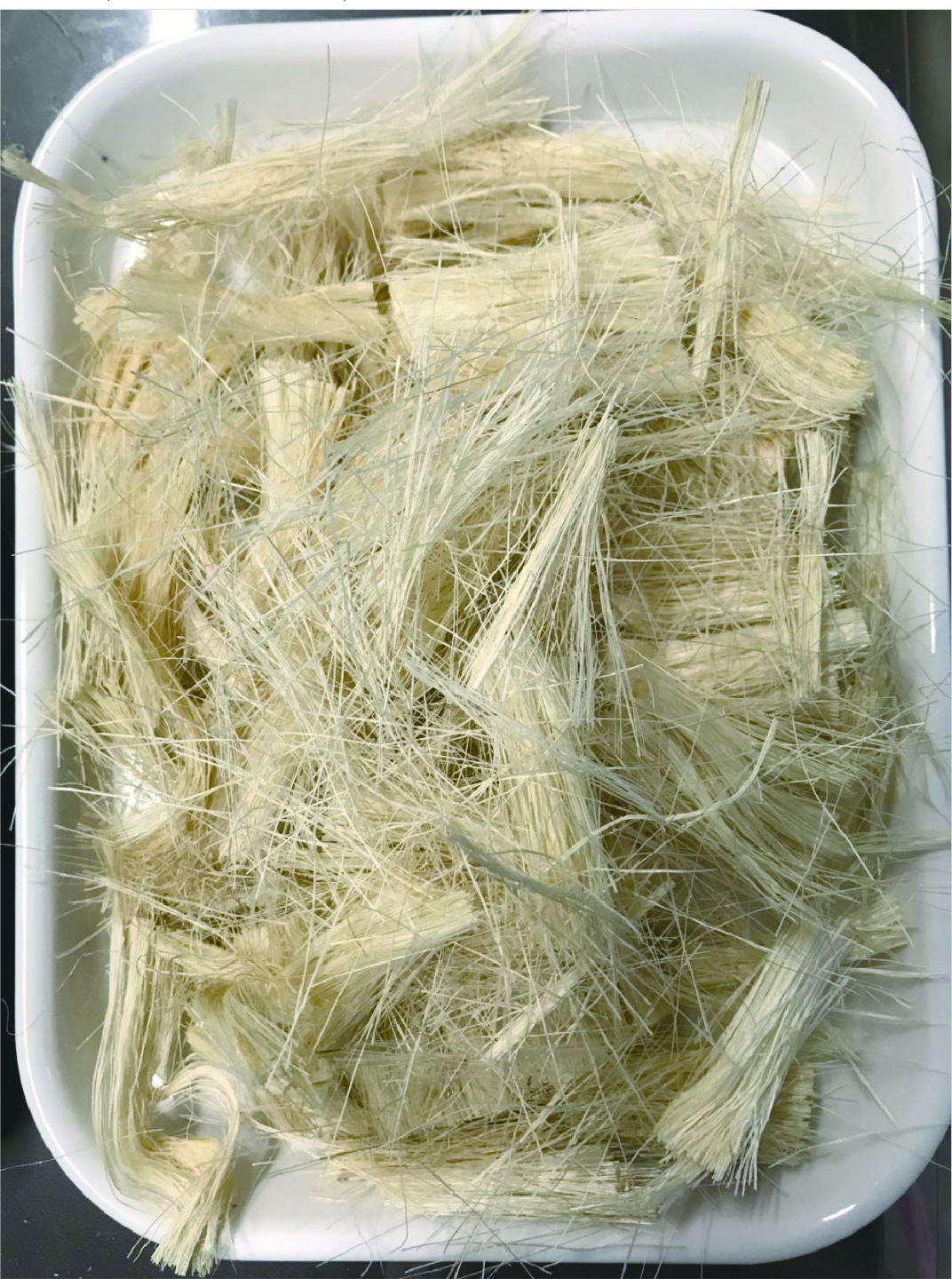
(a)

(b)
Fig.1 Cut sisal fibers. (a) 5 cm; (b) 10 cm
1.2 Mass loss
NaOH solutions of three concentrations (1.0, 0.1, and 0.01 mol/L) were prepared, corresponding to pH values of 13.6, 12.9, and 11.9, respectively. The sisal fibers with a length of 5 cm were used for the mass loss test. First, they were dried in an air oven at 60 ℃ for 12 h to remove residual moisture. Then, the dried fibers (5.00 g) were immersed in the prepared NaOH solution for up to 6 months. At certain time points, some fibers were taken out and repeatedly washed with tap water until the pH of the wash water was close to 7. The fibers were dried again in an air oven at 60 ℃ for 12 h and then weighed. To maintain the alkalinity condition, the NaOH solution was replaced every 7 d.
1.3 Tensile strength
The tensile strength test was performed on an electronic universal testing machine with a capacity of 20 kg. The sisal fibers with a length of 10 cm were used. The gauge length was set at 45 mm. The load was applied at a constant rate (20 mm/min). The tensile strength σ of a single fiber was calculated using the following equation:
(1)
where F is the load at failure, and A is the cross-sectional area of the tested fiber.
At least 20 fibers were tested to reduce error. The measurements that exceeded ±50% of the mean value were eliminated, and the average of the remaining was taken. Nondestructive testing using an optical microscope is proposed to improve the measurement accuracy of the cross-sectional area. The experimental details are available in our earlier publication[16].
1.4 Crystallinity index
X-ray diffraction (XRD) analysis was performed on sisal fibers at a scanning rate of 0.02°/s and a 2θ range of 5° to 40°. The fibers were cut and passed through a 60-mesh sieve to obtain the analysis samples.
Fig. 2 shows the XRD pattern of the sisal fibers. The relatively intense peak centered at 22° to 23° corresponds to the (002) lattice plane of cellulose[4]. The broad peak between 13° and 18° is related to the amorphous phase. The crystallinity index of the fiber can be calculated using the following equation[17]:
(2)
where Icr is the crystallinity index; I002 is the maximum intensity of diffraction of the (002) lattice peak; and Iam is the diffraction intensity of the amorphous phase, which is taken as the 2θ angle between 18° and 19°, where the intensity is minimum. The crystallinity index of sisal fibers was calculated as 46.1%.
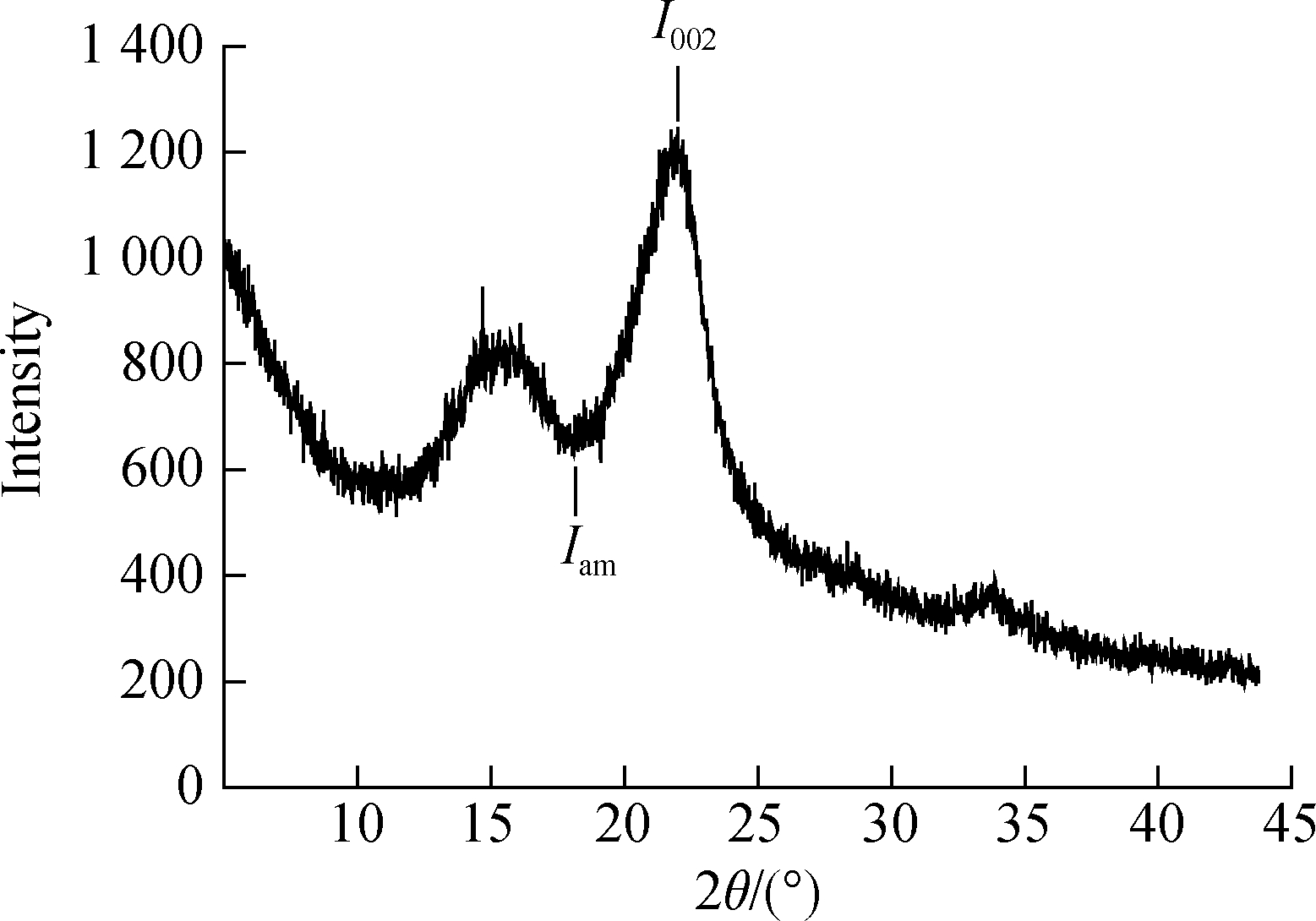
Fig.2 The XRD pattern of sisal fibers
1.5 Microstructure
The microstructure of sisal fibers was characterized using a field-emission scanning electron microscope. The sisal fibers were fixed on an aluminum stub using an electrically conductive adhesive and coated with a thin layer of gold to improve their electrical conductivity.
2 Results and Discussion
2.1 Mass loss
The mass loss of sisal fibers immersed in the alkaline solution at various pH conditions over time is shown in Fig. 3.
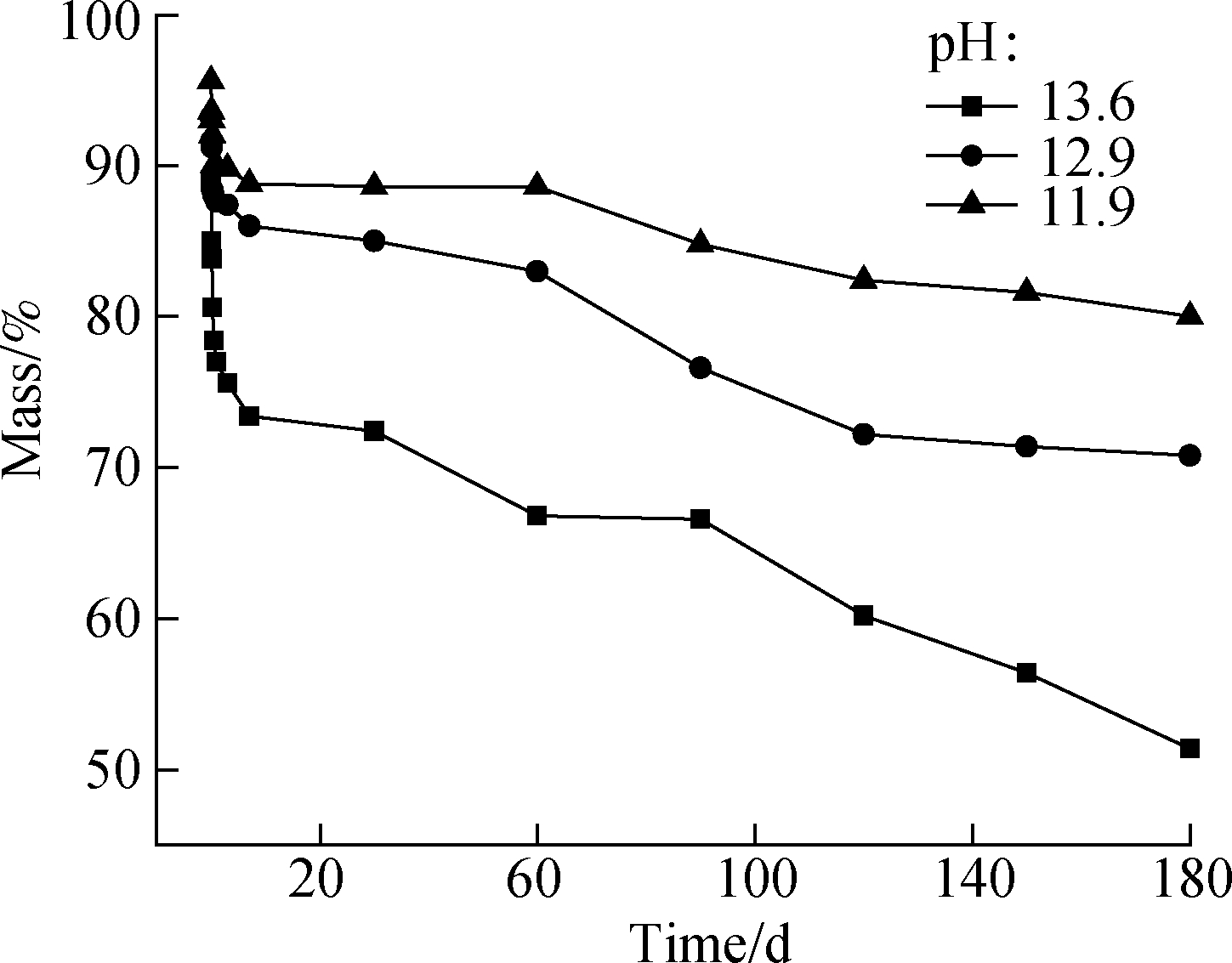
Fig.3 The mass loss of sisal fibers degraded at various pH values over time
The fiber mass remarkably decreased in the first 7 d and then steadily decreased. After day 7, the sisal fibers degraded at pH 13.6, 12.9, and 11.9 exhibited mass losses of 26.6%, 14.0%, and 11.2%, respectively. The rapid mass loss was due to the hydrolysis of amorphous phases, such as lignin and hemicellulose, at the fiber surface[4, 6]. The sisal fibers degraded at pH 13.6 retained only 51.4% of the original mass after 6 months, indicating severe degradation, while the sisal fibers degraded at pH 11.9 exhibited only a small mass loss after 6 months.
2.2 Tensile strength
The tensile strength of the original sisal fibers was 234 MPa. The tensile strengths of the fibers after alkaline degradation are illustrated in Fig. 4.

Fig.4 Tensile strengths of sisal fibers after degradation at various pH conditions over time
The sisal fibers exhibited negligible changes in tensile strength after degradation over 7 d, regardless of the pH conditions. However, the tensile strength significantly decreased to 181 and 195 MPa after 1-month degradation at pH 13.6 and 12.9, respectively, and decreased by about 50% after 6-month degradation at pH 13.6. The tensile strength increased after 6-month degradation at pH 11.9, attributable to the reduction in the cross-sectional area due to hydrolysis of the amorphous phase. Therefore, multiscale characterization is needed to better evaluate the degradation degree of natural fibers.
2.3 Crystallinity index
The crystallinity index calculated according to the XRD patterns of the degraded sisal fibers is presented in Fig. 5. The crystallinity index gradually increased with the pH and time. The crystallinity index remarkably increased to 96.95% after 6-month degradation at pH 13.6, suggesting that a majority of the amorphous phase had been hydrolyzed by the highly alkaline solution, consistent with the large mass loss.
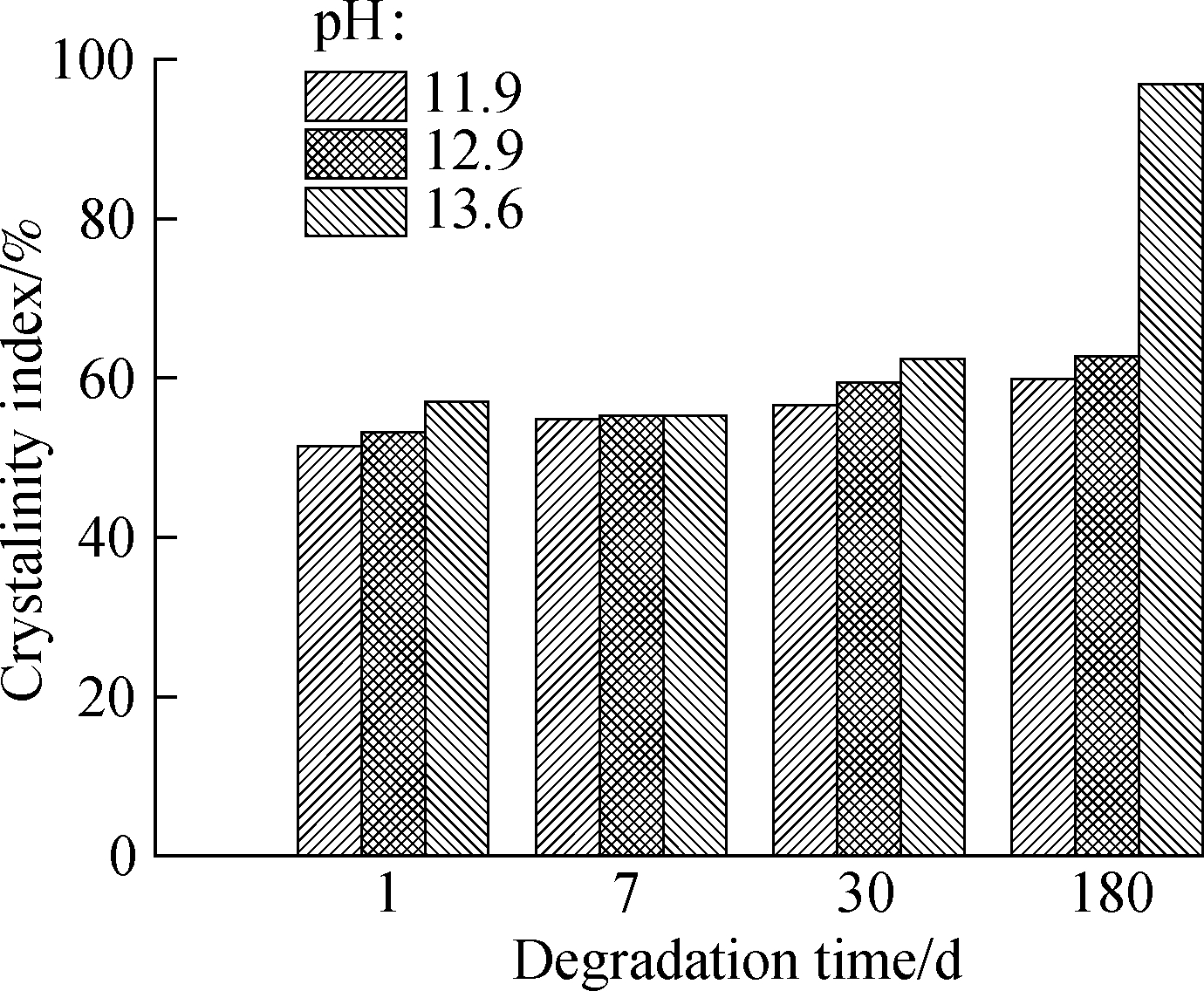
Fig.5 Crystallinity index of sisal fibers after degradation at various pH conditions over time
2.4 Microstructure
As shown by the scanning electron microscopy (SEM) images, sisal fibers degraded at different pH conditions exhibited marked differences in the microstructure.
The sisal fibers exhibited a rough surface, characterized by a sequence of ridges and valleys (see Fig. 6(a)). The cross-sectional SEM image (see Fig. 6(b)) showed that the fibers consisted of numerous elongated fiber cells and lumen space. A previous study reported that the fiber cells were united by lamellae consisting of lignin and hemicellulose[18]; the fiber cells were assembled by numerous cellulose microfibrils, which were also linked by lignin and hemicellulose[18].
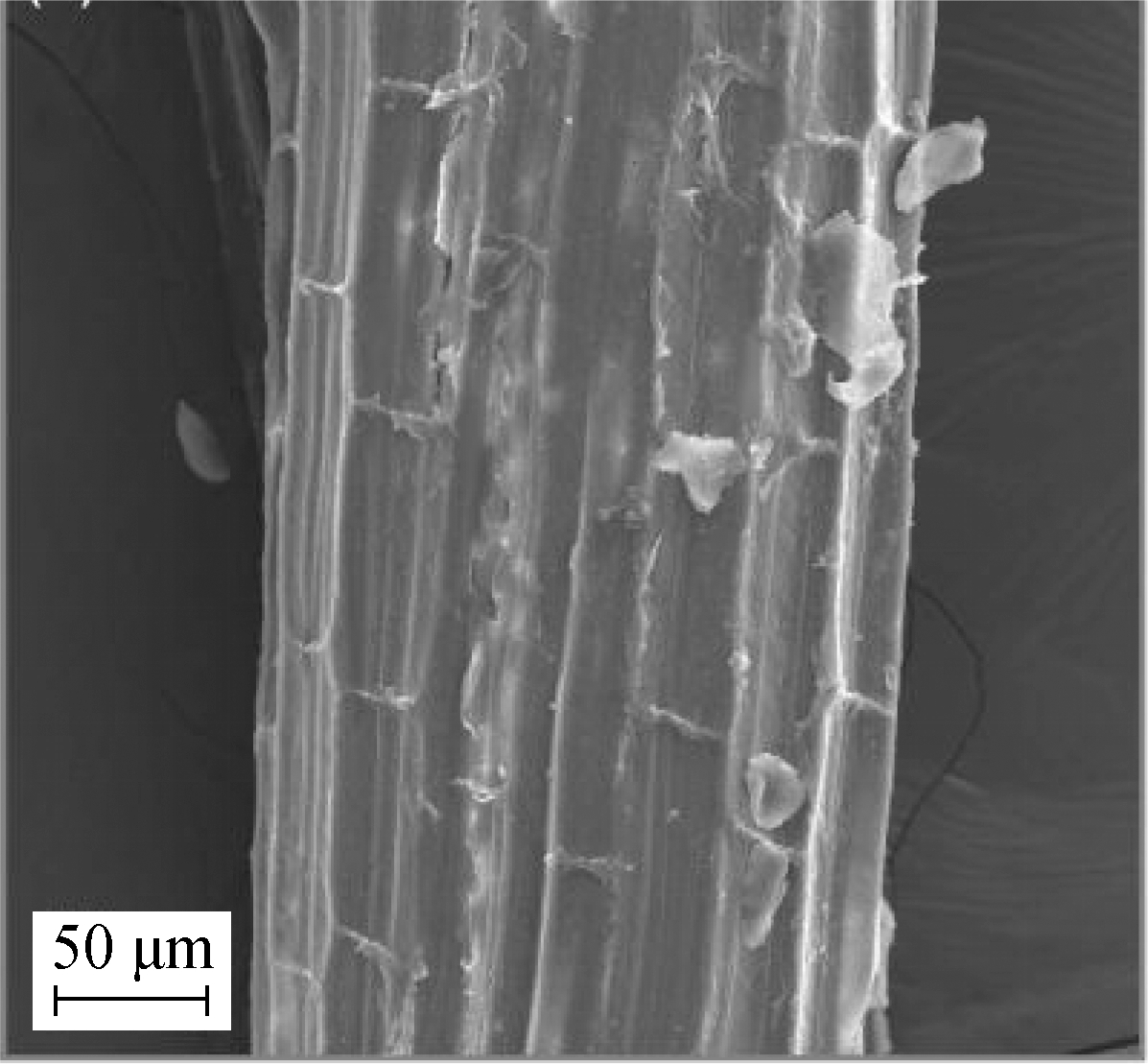
(a)
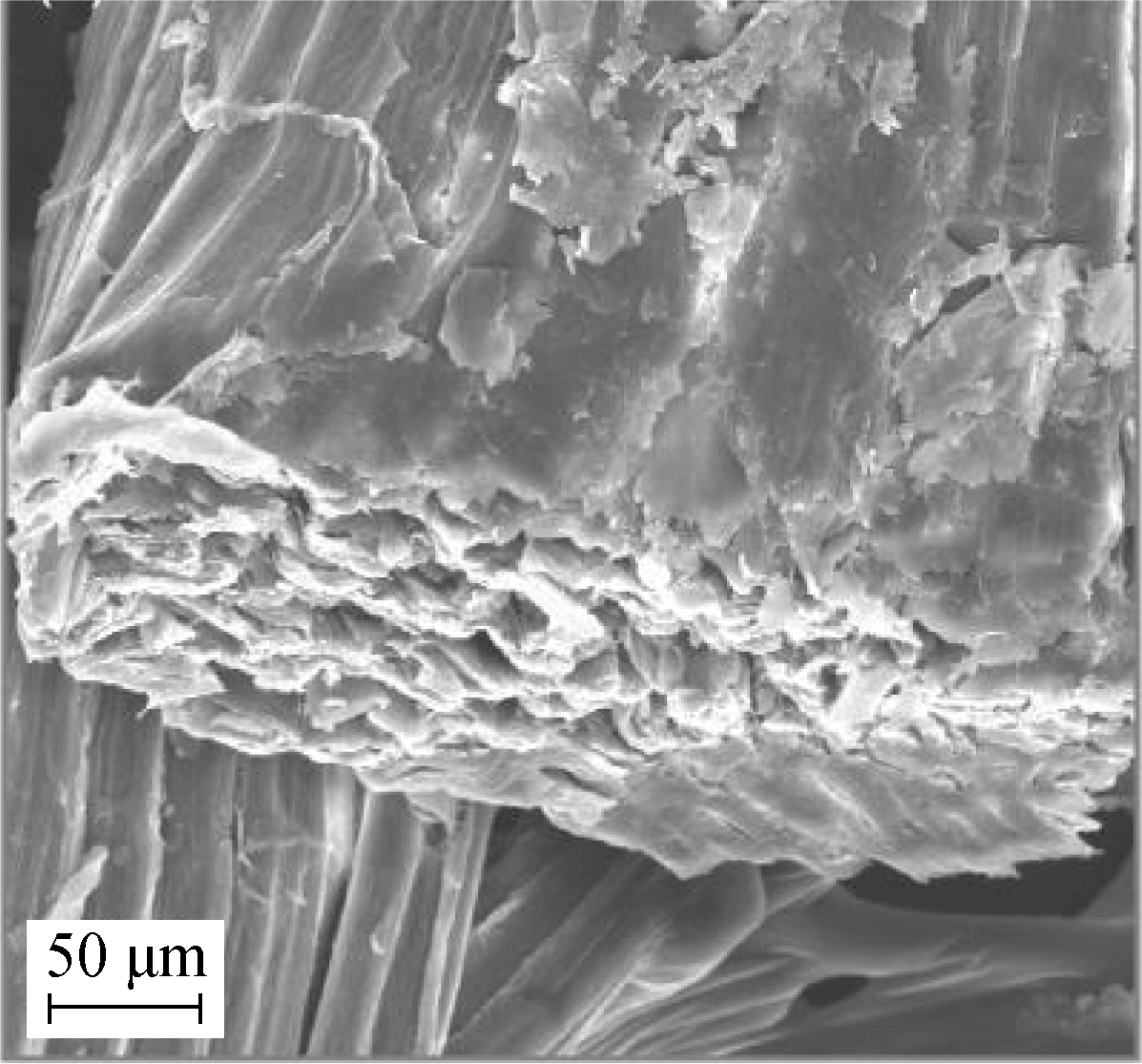
(b)
Fig.6 SEM images of sisal fibers. (a) Surface; (b) Cross-section
After degradation over 7 d, the surface roughness of sisal fibers substantially increased (see Fig. 7), attributable to the rapid hydrolysis of the amorphous phase at the fiber surface, consistent with the sharp mass loss. Particularly, the sisal fibers degraded at pH 13.6 exhibited distinct surface microfibrils (see Fig. 7(a)).
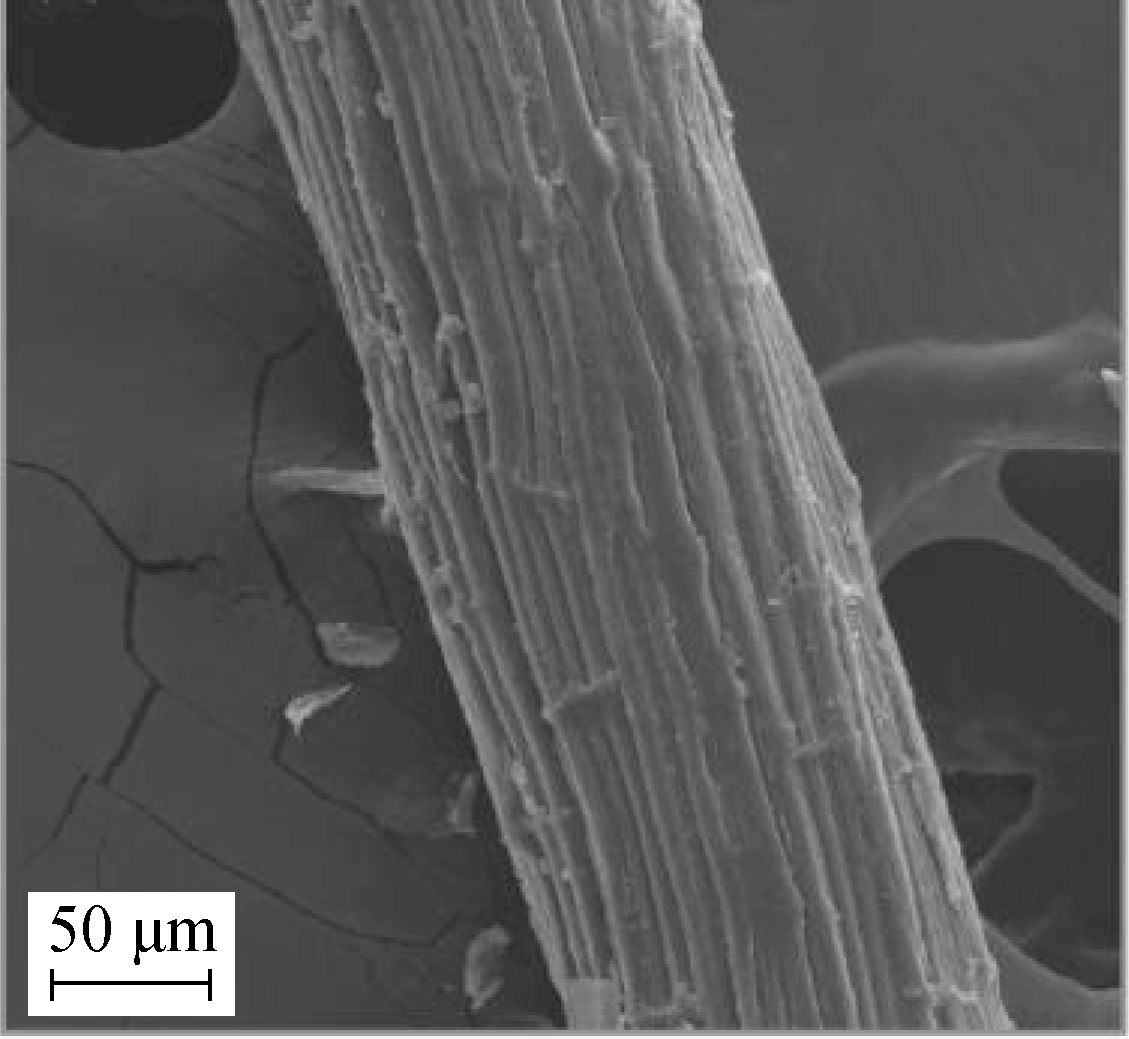
(a)
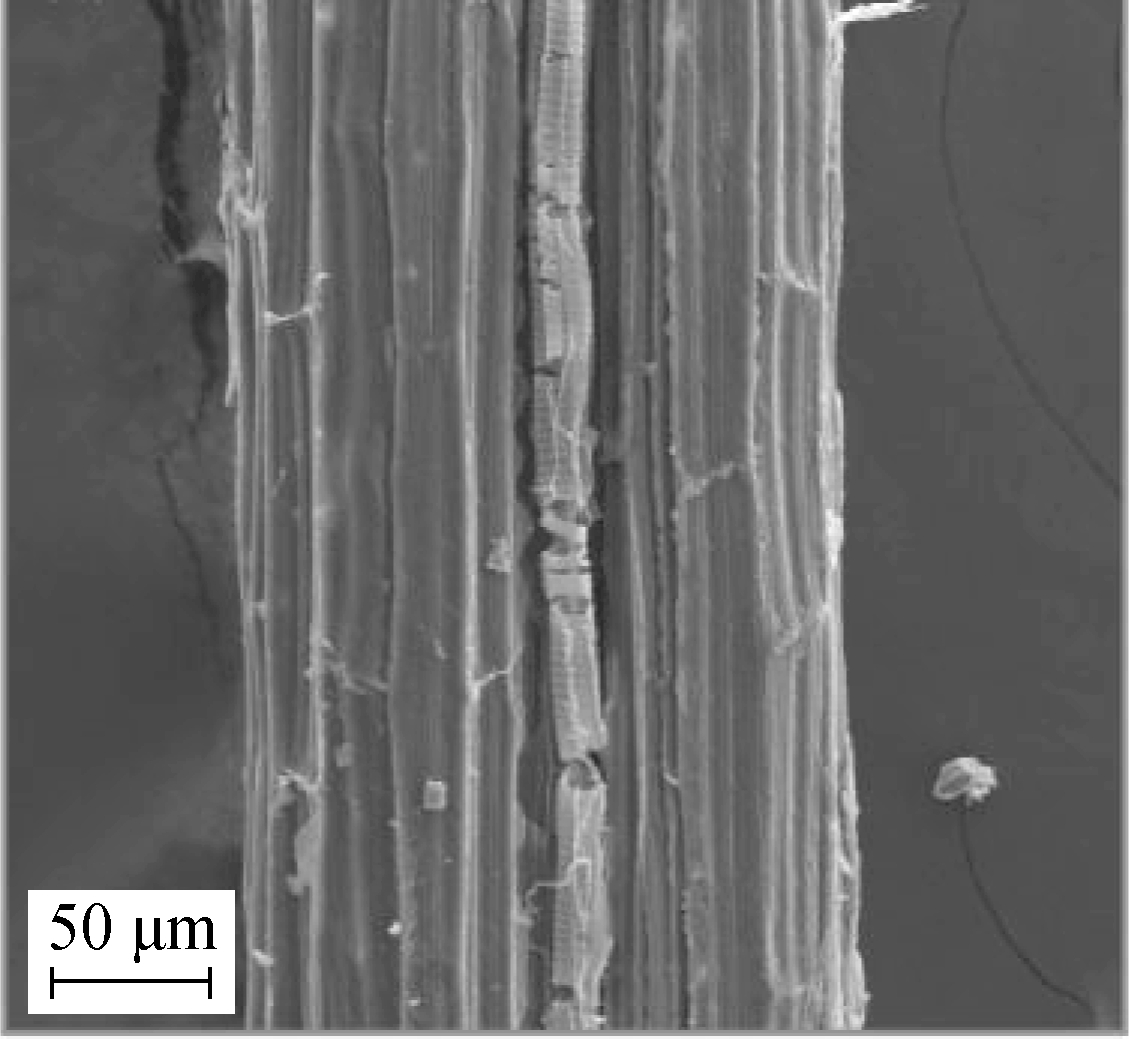
(b)
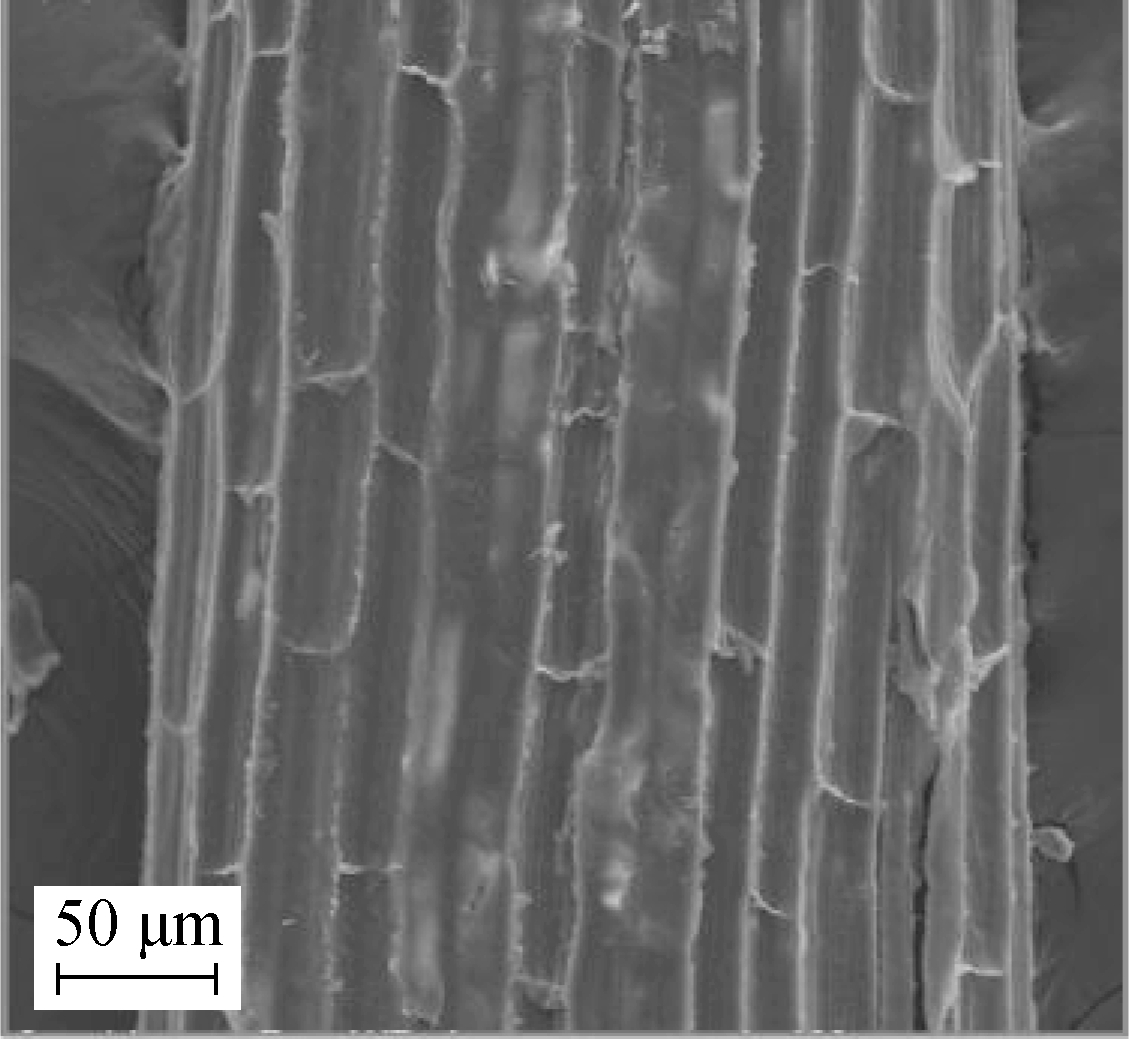
(c)
Fig.7 SEM images of sisal fibers after 7-day degradation. (a) pH=13.6; (b) pH=12.9; (c) pH=11.9
The sisal fibers degraded at pH 13.6 and 12.6 over 1 month exhibited loosely bound microfibrils (see Figs. 8(a) and (b)), attributable to the gradual hydrolysis of the linking materials such as lignin and hemicellulose.
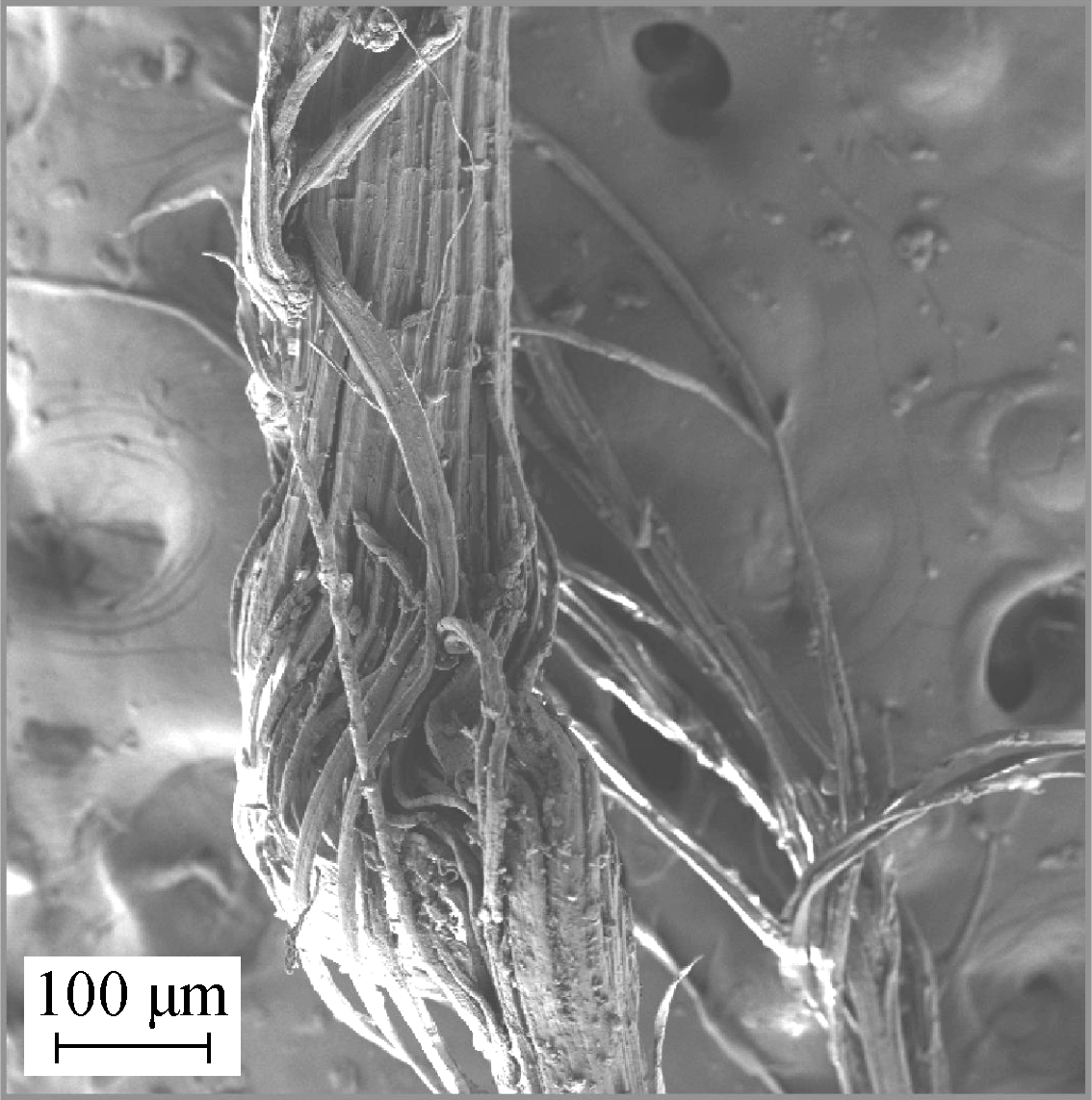
(a)
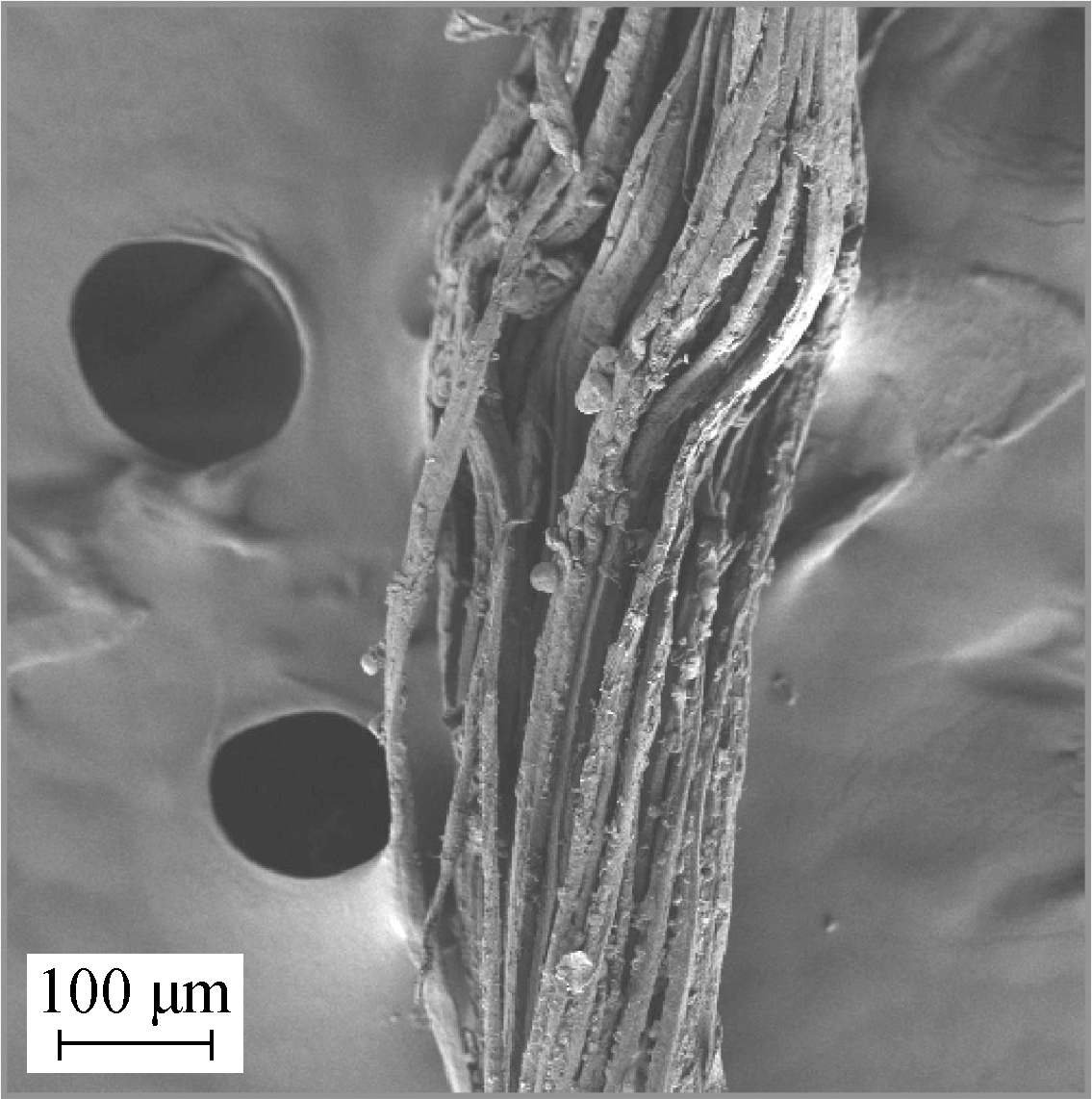
(b)
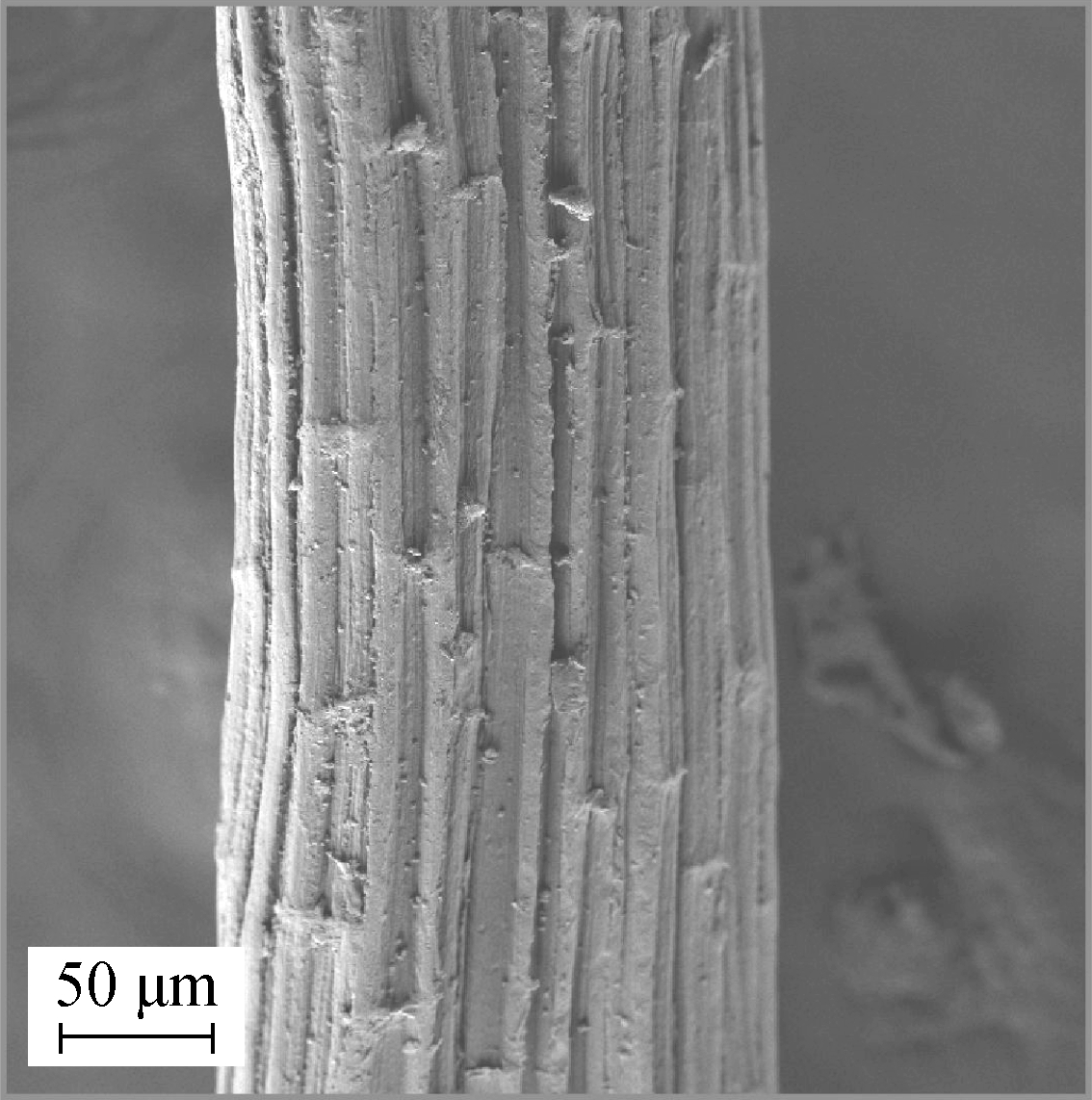
(c)
Fig.8 SEM images of sisal fibers after 1-month degradation. (a) pH=13.6; (b) pH=12.9; (c) pH=11.9
After 6-month degradation at pH 13.6, the fiber integrity was completely damaged, and the majority of microfibrils were stripped (see Fig. 9(a)), which is the main reason for the remarkable reduction in tensile strength. Stripped microfibrils also occurred in some areas of the sisal fibers degraded at pH 12.9 over 6 months (see Fig. 9(b)). The fibers degraded at pH 11.9 exhibited bundled microfibrils with no signs of stripping (see Fig. 9(c)).
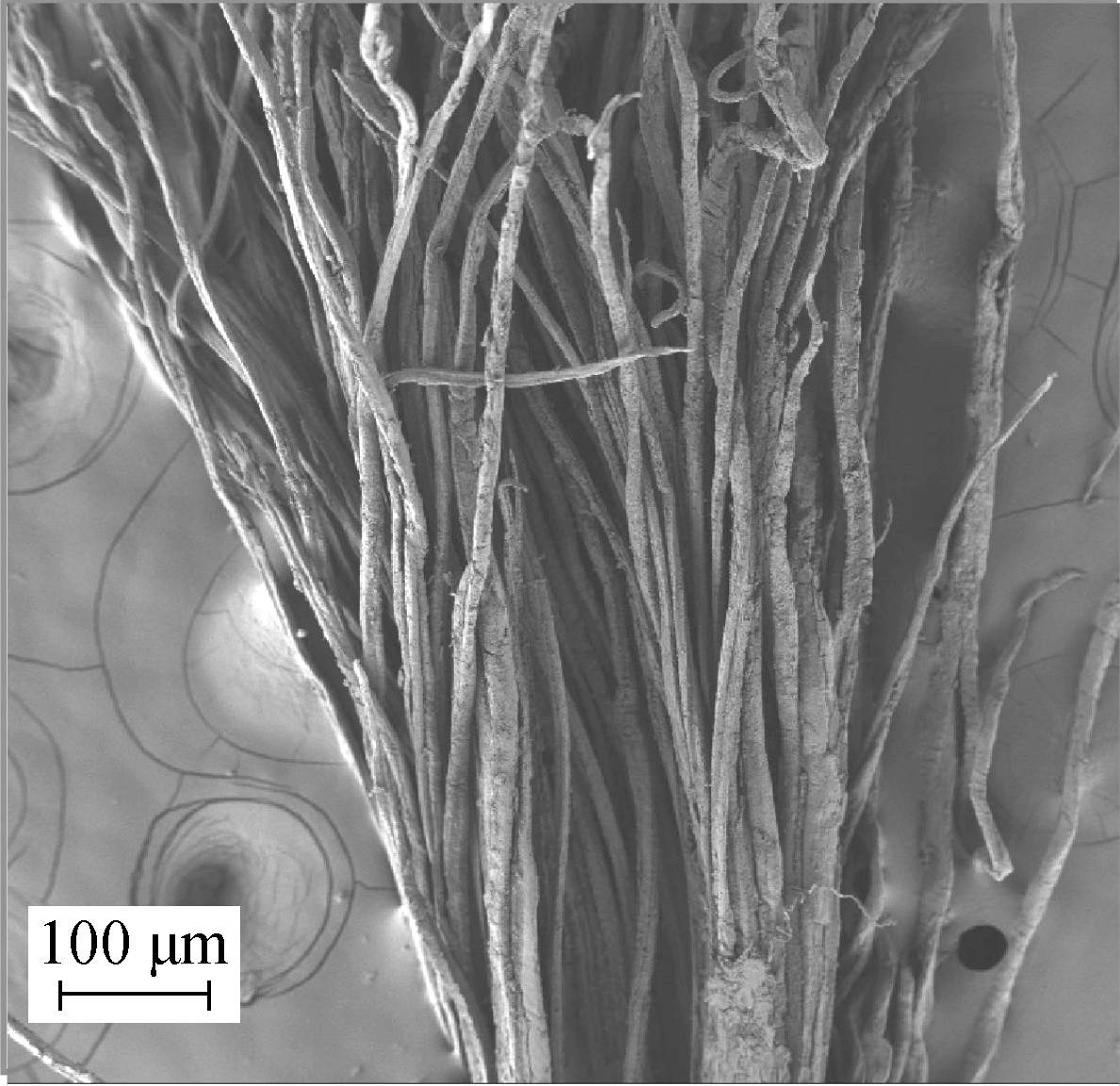
(a)
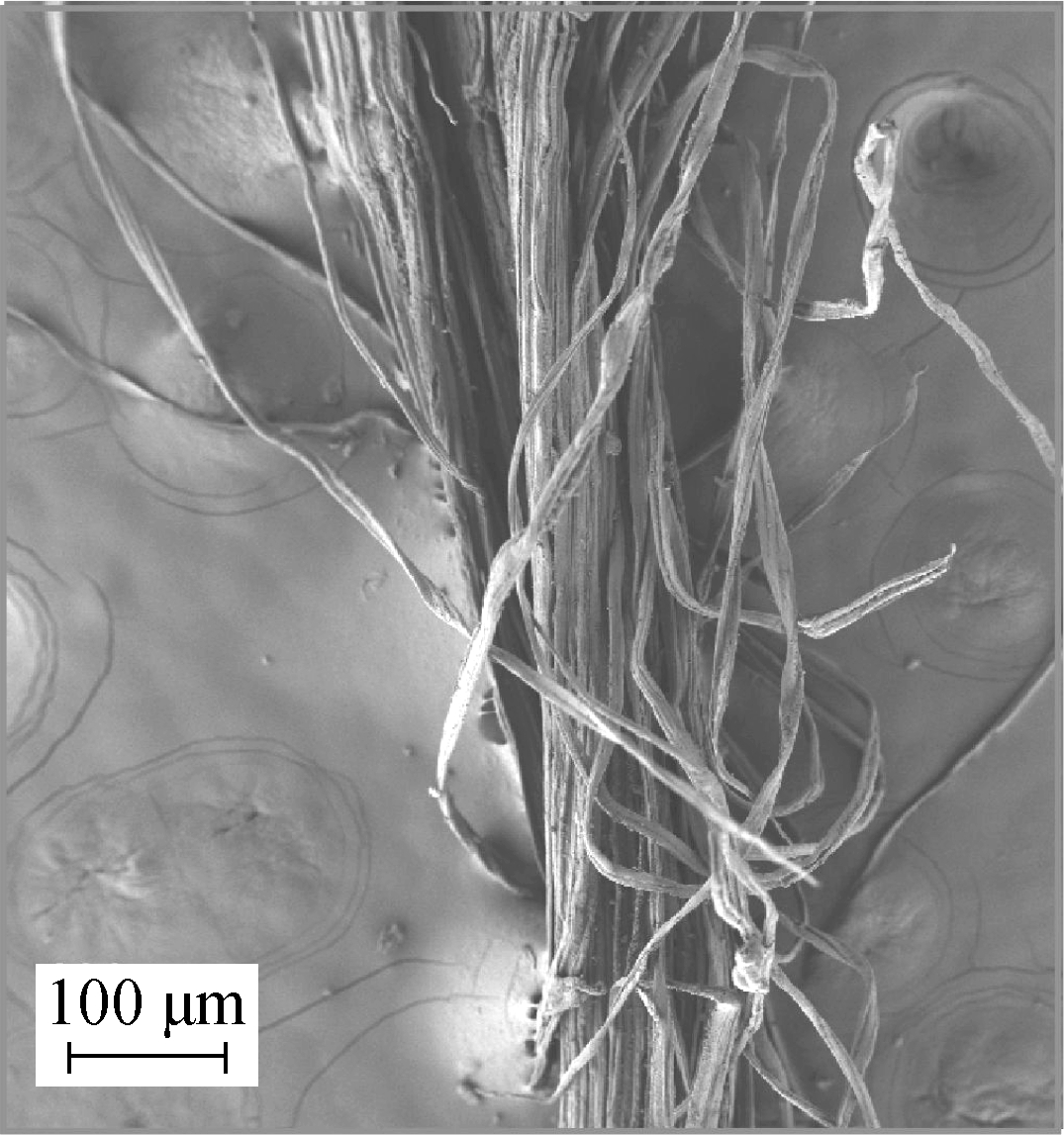
(b)
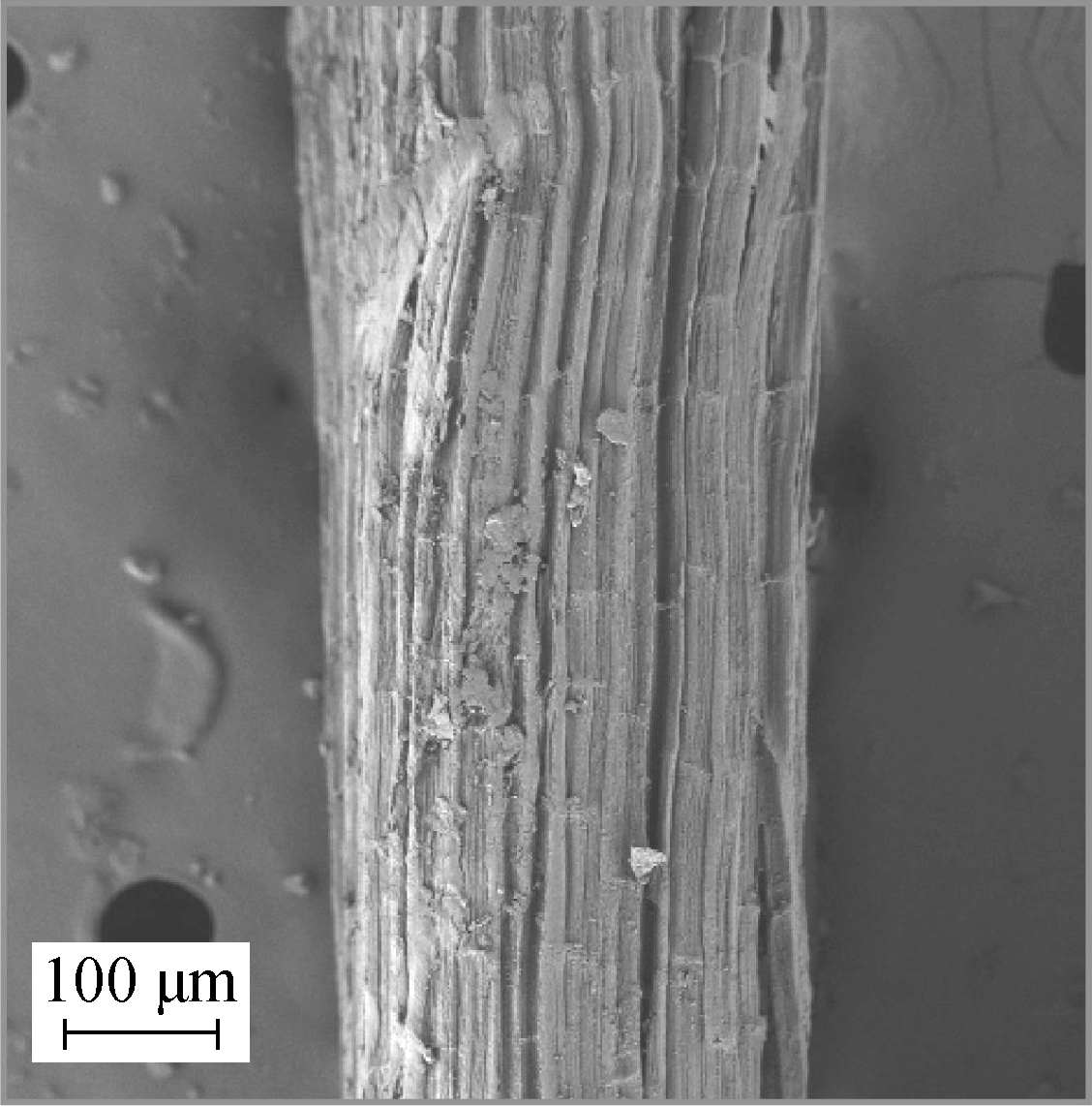
(c)
Fig.9 SEM images of sisal fibers after 6-month degradation. (a) pH=13.6; (b) pH=12.9; (c) pH=11.9
3 Alkaline Degradation Behavior of Natural Fibers
Natural fibers have a hierarchical structure[4, 18-19] and are mainly composed of cellulose, hemicellulose, and lignin. Cellulose, serving as the load-bearing component, exists as a crystalline phase consisting of numerous microfibrils. Lignin and hemicellulose, which are responsible for the fiber integrity, are amorphous phases existing at the surface and lamellae between fiber cells and microfibrils. Lignin and hemicellulose can be hydrolyzed in an alkaline environment[4, 6]. According to the hierarchical structure of natural fibers and the experimental results of this study, a three-stage alkaline degradation process of natural fibers is proposed, as depicted in Fig. 10.
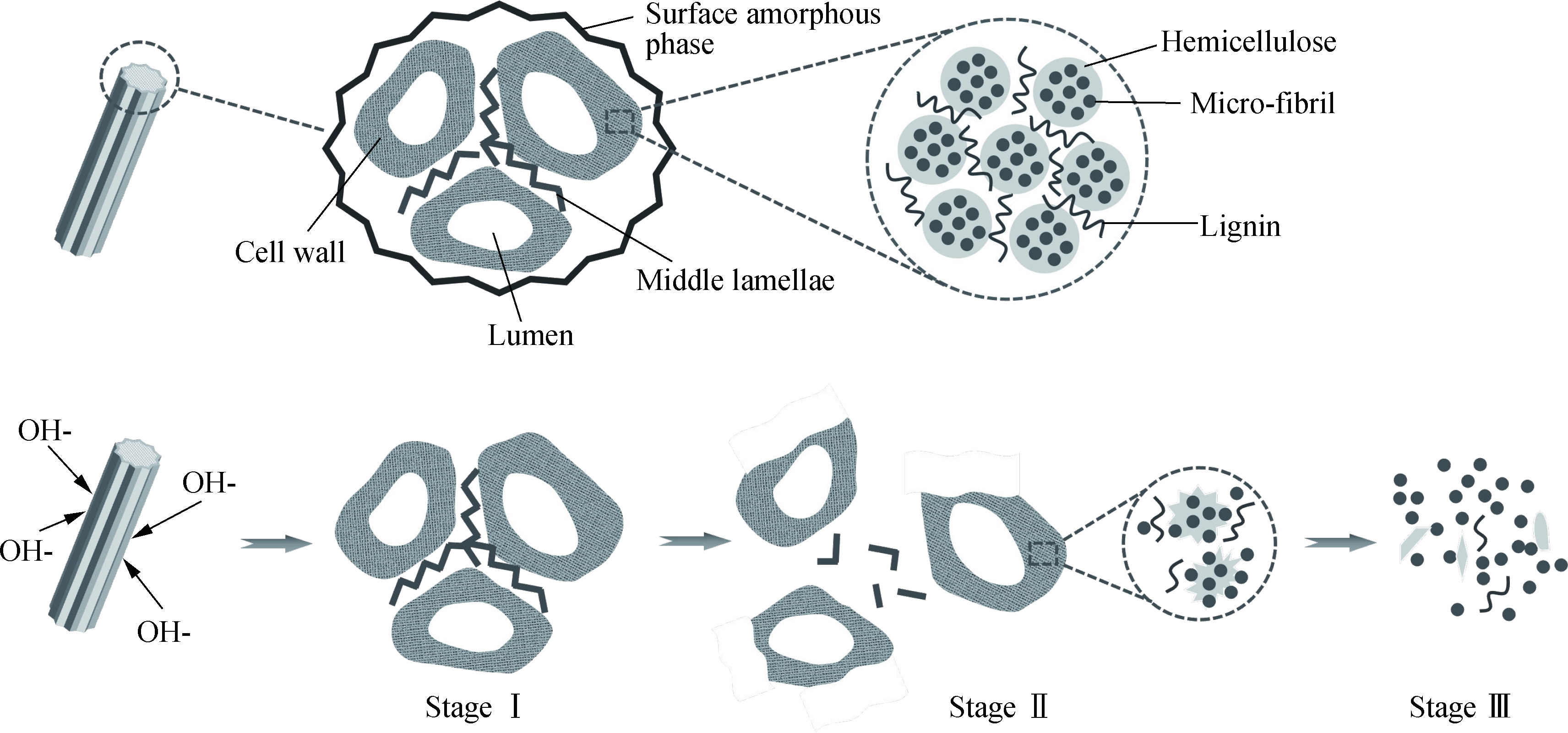
Fig.10 Alkaline degradation process of natural fibers
Stage Ⅰ: Upon the exposure of natural fibers to an alkaline environment, lignin and hemicellulose on the fiber surface are rapidly hydrolyzed, leading to a sharp decrease in fiber mass and a great increase in surface roughness. In this stage, the fiber integrity is not damaged; thus, the change in tensile strength is only marginal.
Stage Ⅱ: With the hydrolysis of lignin and hemicellulose on the fiber surface, the alkaline solution penetrates into the fiber and dissolves the lignin and hemicellulose between the fiber-cells and microfibrils. Over time, the fiber mass steadily decreases, and the crystallinity index gradually increases. However, the tensile strength remarkably decreases owing to the loosely bound microfibrils.
Stage Ⅲ: With the continuous hydrolysis of the amorphous phase, the microfibrils become stripped. The damaged fiber integrity deteriorates the fiber mechanical strength and reinforcing capacity.
Reducing the pH of the alkaline environment can effectively mitigate the degradation process of natural fibers. The SCM-OPC system should be better designed so that the pH of the cement pore solution is less than 11.9. The results also highlight the importance of the surface modification of natural fibers to inhibit the rapid damage of the fiber surface caused by the highly alkaline cement pore solution.
4 Conclusion
1) The sisal fibers exhibited a sharp mass loss over the first 7 d of degradation regardless of the pH, owing to the rapid hydrolysis of lignin and hemicellulose at the fiber surface. After day 7, the mass loss rate slowed down.
2) The change in tensile strength was only marginal after day 7 of degradation; however, the sisal fibers exhibited a significant reduction in tensile strength after 1-month degradation at pH 13.6 and 12.9, owing to the loosely bound microfibrils. After 6-month degradation at pH 13.6, the fibers exhibited an about 50% decrease in tensile strength, owing to fiber integrity damage.
3) With continuous hydrolysis of the amorphous phase, the crystallinity index of the sisal fibers gradually increased with the pH and time, except for the fibers degraded at pH 13.6 over 6 months, which exhibited a 96.96% increase in crystallinity index.
4) SEM images revealed that the surface roughness substantially increased after 7-day degradation owing to the removal of lignin and hemicellulose at the fiber surface. With extended degradation, the microfibrils became loosely bound and stripped owing to the continuous hydrolysis of the linking lignin and hemicellulose.
5) The sisal fibers degraded at pH 11.9 largely maintained their integrity and tensile strength, even after 6 months; thus, reducing the environment pH can effectively mitigate fiber degradation.
[1] Yoo D Y, Banthia N. Impact resistance of fiber-reinforced concrete—A review [J]. Cement & Concrete Composites, 2019, 104: 103389. DOI:10.1016/j.cemconcomp.2019.103389.
[2] Zhou C H, Cai L P, Chen Z P, et al. Effect of kenaf fiber on mechanical properties of high-strength cement composites [J]. Construction and Building Materials, 2020, 263:121007. DOI:10.1016/j.conbuildmat.2020.121007.
[3] Guo A F, Sun Z H, Satyavolu J. Impact of modified kenaf fibers on shrinkage and cracking of cement pastes [J]. Construction and Building Materials, 2020, 264: 120230. DOI:10.1016/j.conbuildmat.2020.120230.
[4] Wei J Q, Meyer C. Degradation mechanisms of natural fiber in the matrix of cement composites [J]. Cement and Concrete Research, 2015, 73: 1-16. DOI:10.1016/j.cemconres.2015.02.019.
[5] Xu H. Studies on the performance of vegetable fiber reinforced cement-based composites [D]. Nanjing: Nanjing Hydraulic Research Institute, 2006. (in Chinese)
[6] Filho R D T, Scrivener K, England G L, et al. Durability of alkali-sensitive sisal and coconut fibers in cement mortar composites [J]. Cement & Concrete Composites, 2000, 22(2): 127-143. DOI:10.1016/S0958-9465(99)00039-6.
[7] Kundu S P, Chakraborty S, Majumder S B, et al. Effectiveness of the mild alkali and dilute polymer modification in controlling the durability of jute fibre in alkaline cement medium [J]. Construction and Building Materials, 2018, 174: 330-342. DOI:10.1016/j.conbuildmat.2018.04.134.
[8] Filho J A M, Silva F A, Filho R D T. Degradation kinetics and aging mechanisms on sisal fiber cement composite systems [J]. Cement & Concrete Composites, 2013, 40: 30-39. DOI:10.1016/j.cemconcomp.2013.04.003.
[9] Xie X L. Preparation of cement based composites reinforced with plant fiber and their mechanical properties [D]. Chengdu: Southwest Jiaotong University, 2016. (in Chinese)
[10] Wei J Q. Degradation behavior and kinetics of sisal fiber in pore solutions of sustainable cementitious composite containing metakaolin [J]. Polymer Degradation and Stability, 2018, 150: 1-12. DOI:10.1016/j.polymdegradstab.2018.01.027.
[11] Junior A N, Ferreira S R, Filho R D T, et al. Effect of early age curing carbonation on the mechanical properties and durability of high initial strength Portland cement and lime-pozzolan composites reinforced with long sisal fibers [J]. Composites Part B, 2019, 163: 351-362. DOI:10.1016/j.compositesb.2018.11.006.
[12] Qian R S. The evolution law and numerical simulation of pore solution ion in modern concrete [D]. Nanjing: Southeast University, 2018. (in Chinese)
[13] Chen Y X, Su N, Zhang K T, et al. Effect of fiber surface treatment on structure, moisture absorption and mechanical properties of luffa sponge fiber bundles [J]. Industrial Crops & Products, 2018, 123: 341-352. DOI:10.1016/j.indcrop.2018.06.079.
[14] Sedan D, Pagnoux C, Chotard T, et al. Effect of calcium rich and alkaline solutions on the chemical behaviour of hemp fibres [J]. Journal of Materials Science, 2007, 42: 9336-9342. DOI 10.1007/s10853-007-1903-4.
[15] Gu Huang. Tensile behaviours of the coir fibre and related composites after NaOH treatment [J]. Materials and Design, 2009, 30(9): 3931-3934. DOI:10.1016/j.matdes.2009.01.035.
[16] Zhao L, Zhu S Q, Wu H, et al. The improved resistance against the degradation of sisal fibers under the environment of cement hydration by surface coating of graphene oxide (GO) based membranes [J]. Construction and Building Materials, 2021, 305: 124694. DOI:org/10.1016/j.conbuildmat.2021.124694.
[17] Ferreira S R, Silva F A, Lima P R L, et al. Effect of fiber treatments on the sisal fiber properties and fiber-matrix bond in cement-based systems [J]. Construction and Building Materials, 2015, 101: 730-740. DOI:10.1016/j.conbuildmat.2015.10.120.
[18] Baley C. Analysis of the flax fibres tensile behaviour and analysis of the tensile stiffness increase [J]. Composites: Part A, 2002, 33(7): 939-948. DOI:10.1016/S1359-835X(02)00040-4.
[19] Lima P R L, Barros J A O, Roque A B, et al. Short sisal fiber reinforced recycled concrete block for one-way precast concrete slabs [J]. Construction and Building Materials, 2018, 187: 620-634. DOI:10.1016/j.conbuildmat.2018.07.184.